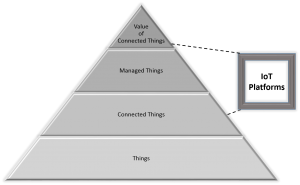
The Internet of Things is Not About Things, Nor is it About the Internet
It seems not a day goes by without seeing breathless headlines predicting the magnitude and the impact of the Internet of Things (IoT). For instance, Morgan Stanley estimates that by year 2020 there will be 75 billion devices. Harbor Research, at the end of the spectrum, forecasts an order of magnitude lower estimate: 8 billion. Cisco offers 50 billion, Gartner counters with 26 billion, and IDC is right in the middle with a forecast of 30 billion connected devices.
Do you get a feeling that they may not really know? Perhaps they are talking about different “things”? And, at the end of the day, does the number of connected devices really matter? And to whom?
Well, it matters to companies like Cisco, ILS Technologies and Mformation, but not to the product companies and brand owners that are trying to decipher the potential impact the Internet of Things could have on their business and on their customers’ business.
The fundamental promise of the IoT is to enable new business models driven by remote connected devices, allowing asset owners and operators obtain up to the minute information about their health, efficiency, output quality and similar key measures and conditions. These devices could also be controlled remotely to adjust operating parameters, update their automation software or even shut down in case of an emergency.
It is therefore clear that while IoT technology facilitates the transmission of information to and from connected assets, its actual value is in the ability to aggregate those data streams and use them for insight, process optimization, and decision making.
Therefore, if you are counting devices and sensors and how many petabytes of data they might generate – you are counting the wrong things.
If you are looking at how these “things” are interconnected and transmit data – you are looking at the wrong end of the process.
IoT Value Realized Outside the IoT Platform
Connective and managing devices isn’t necessarily a simple task. The evolution of IoT connectivity dates back to bespoke machine to machine (M2M) implementations and to non-standard, non-repeatable remote monitoring projects, which resulted in an assortment of incompatible communication methods and protocols, making data interoperability and security difficult to manage.
The IoT industry today is still busy addressing these connectivity challenges. Several software platforms including GE’s Predix, Gemalto, ILS Technology’s DeviceWise and PTC’s ThingWorx, claim to cover the “end to end” process, from connecting disparate devices to monitoring them through snazzy dashboards. Others software vendors, such as Mformation and Red Bend (recently acquired by Harman International), focus on a narrower slice of the IoT technology stack: provisioning and managing remote devices.
But the business value of the IoT is predicated on the ability to aggregate and exploit device data streams for insight, process optimization, and decision making. Most IoT platforms cover some—perhaps most—of device connectivity and manageability needs, but barely scratch the surface when it comes to extracting business value from data and rely on external data analytics tools.

IoT Platforms and Internet of Things Value Realization
And Then, A Miracle Happens!
There isn’t a singular common Internet of Things “problem” and therefore there cannot be not a single IoT “solution.” Business-specific value realization requires data mashup and analysis that are highly domain specific and designed to meet the well-articulated business goals. Connectivity isn’t one of those goals.
An IoT-based business solution must integrate multiple information producers and consumers and synthesize data not only from multiple IoT “things” orchestrated by one of those software “platforms”, but also from other inter and intra enterprise business data repositories that are typically managed by the organization’s ERP and CRM systems.
And this is where some by some IoT technology vendors fall short of the promise. Reviewing the technical architecture and business justification they propose seem to hint at an invisible layer between data aggregation and business value which should be titled, like that famous cartoon, “then a miracle occurs.”
It’s time we broaden the conversation and talk about how to realize the business value of connected devices and the Internet of Things.
Image: The Money Lender and His Wife (Quentin Metsys, 1514)
